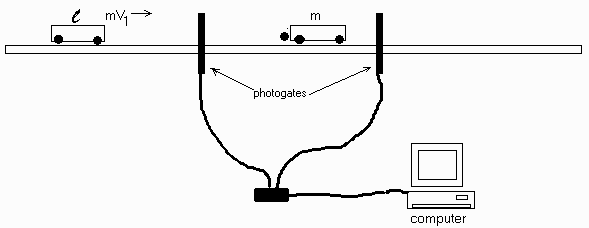
You can click on the image to download it in gif format.

You can click on the image to download it in gif format.
When a cart with a certain mass (m) travels with a certain velocity (V) along a track, it is said to have a certain momentum (p) equal to its mass multiplied by its velocity. When it encounters another cart, it is observed that the sum of the momenta of these two carts does not change. If the carts "stick" somewhat then the collision is called inelastic and the velocity of the two cart system will be given by the sum of the momenta of the carts divided by the total mass of the system.
Equipment needed:
Qualitative: The bearing carts are placed on the track with their velcro ends towards one another. Three chalk lines are drawn on the track, one just in front of the first cart, one just behind the second cart, and one an equal distance from that. A student will push the first cart while the demonstrator counts out loud, starting the count over after the collision. Students should note that all timing is relative to the leading edge of the first cart. If the carts are the same mass they should have half the velocity after the collision by conservation of momentum ( mV=[2m][V/2] ) and it should take twice as long for the first cart to reach the last line. Masses can be added to the second cart, but it would be best for this demonstration to stick to integer multiples of the mass.
Quantitative: The bearing carts are placed as before, but the velcro ends only need to be on the collision side of one cart so that the carts don't jump the track (the velocoty can be measured by the photogates without the assumption of PERFECTLY inelastic collision). The photogates are located (no chalk lines) before the first cart and after the second one. The computer should be hooked up to these and set in gate timing mode for two gates. The velocity of the first cart will be given by its length divided by the time it took to pass. The velocities after the collision become interesting. If the first cart is as massive or more massive, then both carts will continue at some velocities through the second gate. If the second cart is more massive, a small rubber ball can be placed between the carts. This will help the first cart rebound and have its velocity measured again by the first photogate instead of the second.
From the resulting data, the distribution of masses of carts can be obtained. Basically, the difference in momentum of the first cart before and after the collision wil give the momentum of the second cart after the collision. This will give m2 as a fraction of m1 by the equation m2 = m1(Vo - V1)/V2.
(1) The track should be levelled in both directions, so the carts are neither leaning to one side nor accelerating back and forth.
(2) The most impressive way to do the demonstration is also the most difficult, making a light cart collide with a heavy cart. This will cause the light cart to rebound back through the first photogate. This can show that the momentum of one cart can actually come out higher than the momentum of the system, but when added to the momentum vector of the first cart which has rebounded, the system's momentum is conserved.
In order to do this, the combination of masses and anything placed between the carts to help them rebound must be carefully considered and tried out beforehand. The best combination yet discovered is to use the bearing cart labelled "collision cart" for its magnetic ends which can attach a stiff spring (one from a diesel engine masses 91 grams) and an extra 600 grams (bringing the total mass to about 1200 grams). The specific spring may be difficult to locate, and the experiment must be tested beforehand. The point of it is to get the smaller cart to rebound with enough velocity. As the momentum of the small cart decreases (after the collision) the error in the experiment may become large.